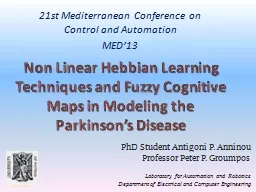

PhD Student Antigoni P Anninou Professor Peter P Groumpos Laboratory for Automation and Robotics Department of Electrical and Computer Engineering 21st Mediterranean Conference on Control and Automation ID: 808876
Download The PPT/PDF document "Non Linear Hebbian Learning Techniques..." is the property of its rightful owner. Permission is granted to download and print the materials on this web site for personal, non-commercial use only, and to display it on your personal computer provided you do not modify the materials and that you retain all copyright notices contained in the materials. By downloading content from our website, you accept the terms of this agreement.
Slide1
Non Linear Hebbian Learning Techniques and Fuzzy Cognitive Maps in Modeling the Parkinson’s Disease
PhD Student Antigoni P. AnninouProfessor Peter P. GroumposLaboratory for Automation and Robotics Department of Electrical and Computer Engineering
21st Mediterranean Conference on Control and AutomationMED’13
27/6/2013
1
Slide2OutlineProblem FormulationFuzzy Cognitive MapsNon-Linear Hebbian LearningDecision Support System in Parkinson’s DiseaseSimulation ResultsConclusions27/6/2013
2
Slide3AimConstruction and training of a Fuzzy Cognitive Map (FCM) in modeling a Decision Support System, to help in diagnosis concerning the disease of Parkinson27/6/20133
Slide4Fuzzy Cognitive Maps (FCM) (1/5)Modeling method for describing particular domainsFyzzy-graph structures for representing causal reasoning27/6/2013
4
Slide5Fuzzy Cognitive Maps (2/5)Nodes: Represent the system’s concepts or variablesArrows: Interconnection between nodes.
Show the cause-effect relationship between them. W: Interrelationship between two nodes:W>0 positive causality W<0 negative causality
W=0 no relationship
27/6/2013
5
Slide6Fuzzy Cognitive Maps (3/5)The value of each concept at every simulation step is calculated, computing the influence of the interconnected concepts to the specific concept, by applying the following calculation rule:
27/6/20136
Slide7Fuzzy Cognitive Maps (4/5)Ai(k+1) : the value of the concept Ci at the
iteration step k+1Ai(k): the value of the concept Cj at the iteration step kWij : the weight of interconnection from concept Ci to concept Cj
k1: the influence of the interconnected concepts in the configuration of the new value of the concept Ai k2: the proportion of the contribution of the previous value of the concept in the computation of the new valuef : the sigmoid function
27/6/2013
7
Slide8Fuzzy Cognitive Maps (5/5)WeaknessesDirect dependence of the initial knowledge of expertsConvergence to undesirable situationsSolutionTraining the FCM
27/6/20138
Slide9Non-Linear Hebbian Learning (NHL) (1/2)Increase the effectiveness of FCMs and their implementation in real problemsUpdate weights associated only with edges that are initially suggested by expertsAll concepts in FCM model are triggered at each iteration step and change their valuesOutput concepts → Desired Output Concepts (DOCs)27/6/2013
9
Slide10Non-Linear Hebbian Learning (2/2)Algorithm that modifies the weights: h:learning parameter g: weight reduction parameterNodes are triggered simultaneously and interact in the same iteration step, and their values updated through this process of interaction
27/6/201310
Slide11Criteria1st : Minimization of the objective function F DOCi: the value of the output concept i as indicated in each iteration Ti: the mean target value of the concept DOCi
m: the number of the desired output nodes2nd : Minimization of the variation of two subsequent values of DOCsF2 = | DOCi (k+1)- DOCi (k) |
27/6/2013
11
Slide12NHL AlgorithmRead input state A0 and initial weight matrix W0Repeat for each iteration step k - Calculate Ai according to (1)
- Update Wij(k) according to (3) - Calculate the two criterion functionsRepeat until the termination conditions are metReturn the final weights Wfinal and concept values in convergence region
27/6/201312
Slide13Schematic Representation of NHL algorithm27/6/201313
Slide14NHL ParametersThe parameters arise from trials and experiments0<h<0.10.9<g<127/6/2013
14
Slide15Decision Support SystemDefinition: Interactive computer – based support system for making decisions in any complex system, when individuals or a team of people are trying to solve unstructured problems on an uncertain environment
Aim: Reach acceptable and realistic decisions Methodology: Exploitation of experts’ experience27/6/201315
Slide16Why to model Decision Support Systems with FCMsHigh amount of data and information from interdisciplinary sourcesInformation may be vague or missingProcedure is complexMany factors may be complementary, contradictory or competitive
27/6/201316
Slide17Decision Making Support System in Parkinson’s Disease (1/2)Concepts:C1: Body BradykinesiaC2: Rigidity
C3: Postural InstabilityC4: Movement of upper limbsC5: GaitC6: TremorC7:
Stage of Parkinson’s disease –five stages (output)27/6/2013
17
Slide18Decision Making Support System27/6/201318
Slide19The Fuzzy Cognitive Map Model27/6/201319
Slide20Simulation ResultsC1StrongC2Strong
C3MediumC4MediumC5StrongC6Very Strong
1st Scenario: Suppose that the physician decided as initial values of the inputs the following:After COA defuzzyfication method the initial values for the concepts would be:
A(0)=[0.75 0.75 0.5 0.5 0.75 1 1]
27/6/2013
20
Slide21Subsequent values of concepts till convergence27/6/2013
21
Slide22OutputWithout the learning algorithmPatient Stage 2 NHL AlgorithmPatient Stage 327/6/2013
22
Slide232nd Scenario:C1WeakC2
WeakC3MediumC4MediumC5StrongC6Zero
After COA defuzzyfication method the initial values for the concepts would be:A(0)=[0.75 0.75 0.5 0.5 0.75 1 1]27/6/2013
23
Slide24Subsequent values of concepts till convergence27/6/2013
24
Slide25OutputWithout the learning algorithmPatient Stage 2 NHL AlgorithmPatient Stage 1
27/6/201325
Slide26ResultsWeight matrices influence the resultEasy to use the proposed software toolWithout the learning algorithm:Few recursive steps (until
9 steps)Fast diagnosisConvergence to undesired equilibrium pointsDemands trainingNHL Algorithm:Much more recursive stepsDifficulty and many trials in order to find the right parameters h and gEquilibrium points closer to the reality
27/6/201326
Slide27Conclusions (1/2)Modeling with this tool closely represents the way experts perceive it NHL algorithm offers more reasonable results according to physiciansNHL algorithm needs more iteration steps in order to reach an equilibrium pointBy using FCM without a learning algorithm to train it, we have a fast model that after a few iteration steps reaches an equilibrium point
The suggested model is easily altered to incorporate other diseases27/6/201327
Slide28Conclusions (2/2)In most cases, FCMs are constructed manually, and, thus, they cannot be applied when dealing with large number of variables. In such cases, their development could be significantly affected by the limited knowledge and skills of the expert. Thus, it is essential to use learning algorithms to accomplish this taskDespite the early obtained encouraging results, we still need the opinion of the physicians as to how useful can this FCM modeling approach be to Parkinson’s disease. Future collaboration and consultation with physicians can help this effort
27/6/201328
Slide29Thank you for your attentionProfessor Peter P. Groumpos
Email: groumpos@ece.upatras.gr
PhD Student Antigoni P.
AnninouEmail:
anninou@ece.upatras.gr
27/6/2013
29